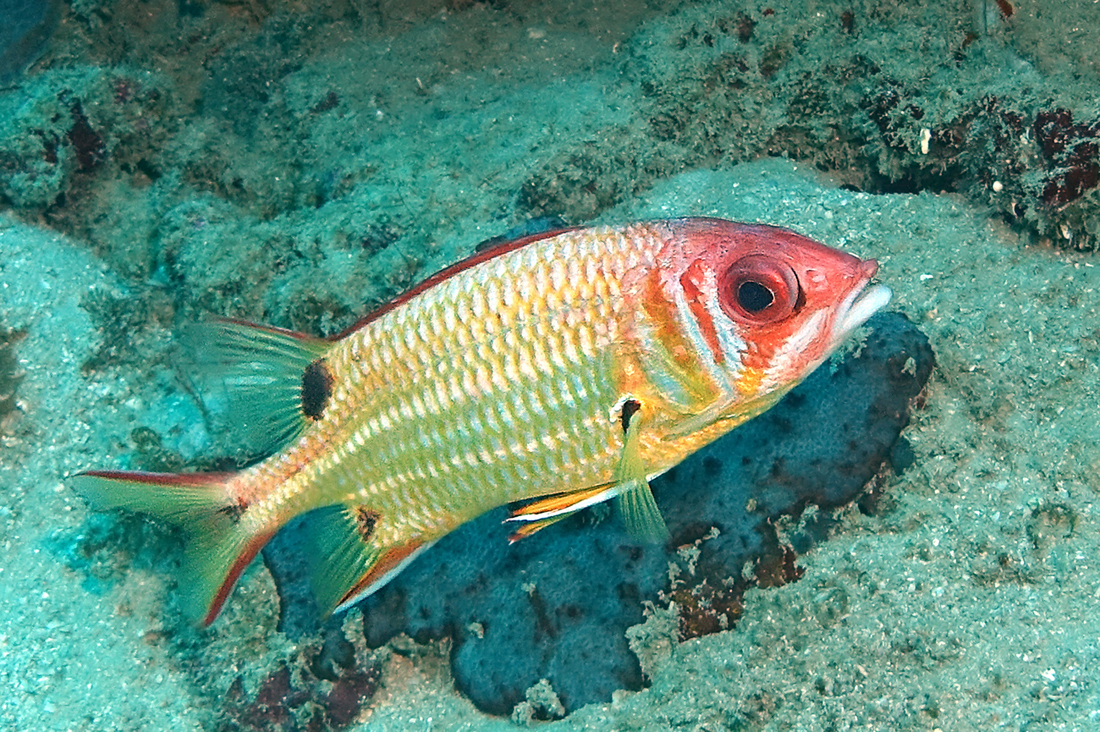- Classification
- ACTINOPTERYGII
- BERYCIFORMES
- HOLOCENTRIDAE
- Sargocentron
- melanospilos
Blackspot Squirrelfish, Sargocentron melanospilos (Bleeker 1858)
Other Names: Blackblotch Squirrelfish, Black-blotched Squirrel-fish, Three-spot Squirrelfish

A Blackspot Squirrelfish, Sargocentron melanospilos, in Lighthouse Bay, Ningaloo Reef, Western Australia, November 2017. Source: glen_whisson / iNaturalist.org. License: CC by Attribution-NonCommercial
Summary:
A yellowish-orange squirrelfish with a black spot at the pectoral-fin base and on the bases of the soft dorsal and anal fins, and a small black spot on the caudal-fin base (the anal and caudal fin spots may be indistinct).
Cite this page as:
Bray, D.J. 2018, Sargocentron melanospilos in Fishes of Australia, accessed 26 Apr 2024, https://fishesofaustralia.net.au/home/species/3153
Blackspot Squirrelfish, Sargocentron melanospilos (Bleeker 1858)
More Info
|
Distribution |
North West Cape, Western Australia, Evans Shoal, Northern Territory, and the northern Great Barrier Reef and reefs in the Coral Sea, to One Tree Island, Queensland. Elsewhere the species is widespread but uncommon in the tropical, Indo-west-central Pacific. Inhabits deep offshore reefs, usually sheltering deep inside caves and under ledges during the day. |
|
Features |
Dorsal fin XI, 12-14; Anal fin IV, 9-10. Body depth 2.7-2.95 in SL; head length (HL) 2.6-2.9 in SL; snout length 3.6-4.4 in HL; interorbital width 4.4-5.25 in HL; slender caudal peduncle, depth 3.9-4.65 in HL; maxilla extending from below centre of the eye to a vertical at rear edge of pupil, upper jaw length 2.25-2.4 in HL; premaxillary groove ending above or slightly posterior to a vertical at the front edge of orbit; anterior end of nasal bone ending with a small spine; surface or medial edge of nasal bone spineless; nasal fossa with 1 to 4 spinules on posterior edge; five oblique scale rows on cheek; preopercular spine 3.45-3.65 in HL; longest dorsal spine 1.95-2.4 in HL; 3rd anal spine 1.5-1.75 in HL. |
|
Species Citation |
Holocentrum melanospilos Bleeker 1858, Acta Societatis Scientiarum Indo-Neerlandicae 3: 2. Type locality: Ambon, Indonesia. |
|
Author |
Bray, D.J. 2018 |
|
Resources |
Blackspot Squirrelfish, Sargocentron melanospilos (Bleeker 1858)
References
Allen, G.R. 1997. Marine Fishes of Tropical Australia and South-east Asia. Perth : Western Australian Museum 292 pp. 106 pls.
Allen, G.R. & Erdmann, M.V. 2012. Reef fishes of the East Indies. Perth : Tropical Reef Research 3 vols, 1260 pp.
Bleeker, P. 1858. Negende bijdrage tot de kennis der vischfauna van Amboina. Acta Societatis Scientiarum Indo-Neerlandicae 3: 1-6
Bleeker, P. 1872. Révision des espèces indo-archipélagiques du genre Holocentrum. Nederlandsch Tijdschrift voor de Dierkunde 4: 198-232
Kuiter, R.H. 1992. Tropical Reef-Fishes of the Western Pacific, Indonesia and Adjacent Waters. Jakarta : PT Gramedia Pustaka Utama 314 pp. pls.
Larson, H.K., Williams, R.S. & Hammer, M.P. 2013. An annotated checklist of the fishes of the Northern Territory, Australia. Zootaxa 3696(1): 1-293
Randall, J.E. 1998. Revision of the Indo-Pacific squirrelfishes (Beryciformes: Holocentridae: Holocentrinae) of the genus Sargocentron, with descriptions of four new species. Indo-Pacific Fishes 27: 1-105 pls 1-11
Randall, J.E. 2005. Reef and shore fishes of the South Pacific. New Caledonia to Tahiti and the Pitcairn Islands. Honolulu : University of Hawaii Press 707 pp.
Randall, J.E., Allen, G.R. & Steene, R. 1990. Fishes of the Great Barrier Reef and Coral Sea. Bathurst : Crawford House Press 507 pp. figs.
Randall, J.E. & Greenfield, D.W. 1999. Family Holocentridae. pp. 2225-2256 in Carpenter, K.E. & Niem, T.H. (eds). The Living Marine Resources of the Western Central Pacific. FAO Species Identification Guide for Fisheries Purposes. Rome : FAO Vol. 4 pp. 2069-2790.
Russell, B.C. 1983. Annotated checklist of the coral reef fishes in the Capricorn-Bunker group, Great Barrier Reef, Australia. Great Barrier Reef Marine Park Authority. Special Publication Series 1: 1-184 figs 1-2
Williams, I. & Greenfield, D. 2016. Sargocentron melanospilos (errata version published in 2017). The IUCN Red List of Threatened Species 2016: e.T67902657A115444251. http://dx.doi.org/10.2305/IUCN.UK.2016-1.RLTS.T67902657A67906340.en. Downloaded on 14 August 2018.






